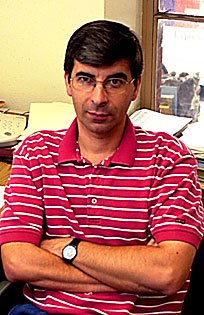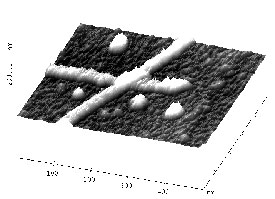 |
|
Pierre Deymier
material science and engineering professor
|
|
|
By Ashley Nowe
Arizona Daily Wildcat
Friday, October 31, 2003
The hand of biology might soon extend into the world of technology, making computers work faster than ever.
A team of eight UA researchers received a $1.23 million grant from the National Science Foundation two months ago to turn a thin type of protein into a wire that will eventually be used to enhance technology.
The thin protein-based wire will be less expensive and more efficient than the microchips that are found in items such as computers, cell phones and cars.
"The current technologies for computers are getting smaller and smaller, but there is still a limit," said James B. Hoying, an associate professor of bio-engineering. "But with this technique we can break that limit and make computer parts even smaller."
Hoying said that 25,000 of these protein wires could be lined up shoulder to shoulder in the space of one millimeter. The miniature diameter of the protein strand means that more wires can fit into a computer device, pushing computers to work at higher speeds than ever before.
"Something like this would make computers faster and faster," said Pierre Deymier, a material
science and engineering professor and one of the co-founders of UA's Nanotechnology Interdisciplinary Research Team. "The smaller the wires, the faster a computer can be."
UA researchers clone these thin strands of protein, called microtubules, by using E-coli bacteria, the same bacteria that is commonly found in the intestines of humans and animals.
The protein reacts to the E-coli strain by multiplying, which results in a long tube-like strand, similar to a straw.
 |
|
IMAGE COURTESY OF PROFESSOR ENIKO ENIKOV
|
An atomic force microscopy image reveals the pattern of protein-based ╬wires' resting on a tiny silicone wafer. Eight UA researchers were awarded $1.23 million to research this technology. The new ╬wires' will allow electronic components to be made even smaller.
|
|
|
The team then coats the straw-like structure with metal, and a wire is born.
The result is a much thinner wire than is found in traditional microchips.
The problem researchers still have is figuring out how to get the wires to connect to the proper points, which is needed to have an electronic circuit.
"The microtubules grows like a firework," Deymier said. "Among all the hundreds of strands that grow from the starting point, only one or two will connect where we want it to."
Even if one of the tiny wires doesn't connect, the chip won't function.
To assure a connection between the wires, UA researchers would ideally place the protein at a starting point and then add the E-coli bacteria to it. At the point where researchers want the strand to end, they would place another short protein that will only link up with a properly formed wire.
This new technology could be used not only in computers, but also in sensors and small electronic circuit structures.
"This is really going to change technology," Hoying said. "This will be a whole new paradigm of technology, leading to the hybrid between biology and technology."
This new idea of biology joining technology could even result in water-based computers in the future, Hoying said.
"It is just so exciting to think about and that is what makes it fun," he said.
The professors who landed the four-year grant work in various departments across campus, including the College of Engineering, the College of Medicine, the College of Science, and the College of Bio Engineering.
